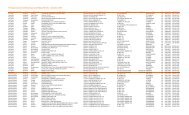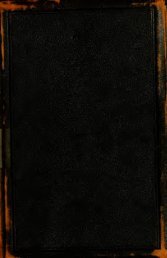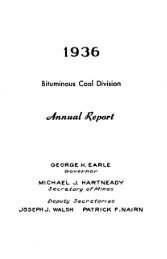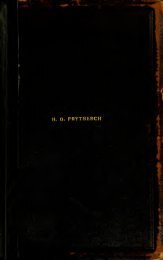1873 - Old Forge Coal Mines
1873 - Old Forge Coal Mines
1873 - Old Forge Coal Mines
You also want an ePaper? Increase the reach of your titles
YUMPU automatically turns print PDFs into web optimized ePapers that Google loves.
INSPECTORS OF MINES. 71<br />
Rule.—To convert Fahrenheit's to Centigrade's deduct 32° and -\- by 18°.<br />
To convert Centigrade's to Fahrenheit's, -f by 18 and plus 32°. To convert<br />
Fahrenheit's to Bearaur's deduct 32° -fby<br />
4, and -=- by 9°. To convert<br />
Beamur's to Fahrenheit's -f- 9°, -f- by 4°, and plus 32°.<br />
A very little practice in these calculations will very soon perfect a person<br />
in this rule, and is undoubtedly correct. The value of the use of this instrument<br />
in mines cannot be too highly recommended in ascertaining the<br />
character and condition of the air by its temperatures.<br />
Barometer. — Its name implies "air meter," by which the weight of the<br />
atmosphere is nicely measured. There are many patterns of barometers in<br />
use, but we only wish in this case to describe the Aneroid instrument, being<br />
the one used by the inspectors of mines. The Aneroid instrument ranges<br />
in size from 2 to 6 inches in diameter, and registers by an index on its<br />
watch-like disk the different changes in i.he atmosphere from stormy,<br />
much rain, rain, change, fair, set fair, to very dry weather. The sweep of<br />
the disk is graduated in inches, from 1 to 31 inches ;<br />
each inch is graduated<br />
into 10,000 parts. The atmospheric pressure upon every square inch of<br />
our globe at the sea level is ascertained to be 14.72 lbs., when the barometer<br />
indicates 30 inches, and the temperature found by the thermometer to<br />
be 60° Fahrenheit, 100 cubic inches of air weighs 30^^ grains avoirdupois,<br />
while 100 cubic inches of water would only weigh 25^ grains. Air of<br />
this density is taken as a standard of density, or the zero of its weight, but<br />
under contrary conditions it weighs heavier when it indicate 31 inches to<br />
15 pounds per square inch, and this weight is adopted ;<br />
but when the instrument<br />
indicates 2S inches the weight per square inch is not so great as<br />
will be observed by a table hereto annexed.<br />
The air grows more lighter as we ascend above sea level, and heaver as<br />
we decend below sea level.<br />
The use of a barometer in coal mines, in connection with the thermometer,<br />
is for the purpose of detecting gases. First—These instruments are<br />
used at the head of the slopes or shafts to ascertain the temperature of the<br />
outside atmosphere by the thermometer, and its weight or gravity by the<br />
barometer. The operator makes note of these conditions, enters the<br />
mine and approaches the district which he desires "to examine. Here he<br />
examines both these instruments and makes note also; then, by the indication<br />
on the thermometer, he sees the temperature of the mine is many degrees<br />
higher than it was found outside. It determines the condition of the<br />
air to be warmer, and consequently expansive in the proportion as shown<br />
by the table. Then should the barometer fall below its outside indication,<br />
or stand at its original point, notwithstanding the depth of the shaft,<br />
it at once indicates the rarity of the air in the mine to be so much lighter,<br />
showing that if the mine air was pure and at such a depth, it ought to indicate<br />
heavier. But when such is not the case, it determines the fact that<br />
under such condition the air is diluted with fire-damp gas, which causes it<br />
to become rarified and lighter, so that the person using the instruments<br />
observes the changes instantly, and declares the<br />
true character of the air,<br />
and by reference to the table may determine its true condition. He then<br />
uses his safety lamp to make the necessary examination of the locality, and<br />
should he find its ventilation defective he would at once direct a remedy<br />
for security. He would then use his anemometer to ascertain the quantum<br />
of air supplied, and if not found satisfactory he would still direct the necessary<br />
increase in the volume of air, sufficient for the removal of the noxious<br />
element, so as to make it safe. He would still continue his explorations<br />
of the other districts of the mine in like manner, making the neeessary<br />
tests and keeping bis notes of the same until the conclusive evidence




![1945 Anthracite Annual Report Districts 19 - 25 [Adobe pdf - 9148Kb]](https://img.yumpu.com/50308099/1/190x119/1945-anthracite-annual-report-districts-19-25-adobe-pdf-9148kb.jpg?quality=85)


![1937 Anthracite Annual Report Districts 1 - 11 [Adobe pdf - 9394Kb]](https://img.yumpu.com/43539962/1/190x119/1937-anthracite-annual-report-districts-1-11-adobe-pdf-9394kb.jpg?quality=85)






![1931 Anthracite Annual Report Districts 1 - 11 [Adobe pdf - 8007Kb]](https://img.yumpu.com/39427789/1/190x119/1931-anthracite-annual-report-districts-1-11-adobe-pdf-8007kb.jpg?quality=85)

